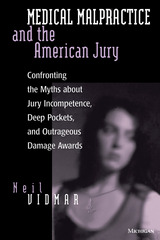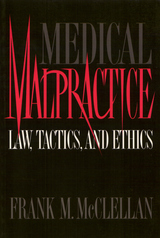


Written in a thoroughly inviting, jargon-free style, Medical Malpractice and the American Jury places those cases that go to trial in the broader context of litigation, noting that only about ten percent of malpractice cases ever result in trials. Of those that do go to trial, the author notes, more than two out of three cases are decided in the doctor's favor--repudiating the view that jurors are inherently biased against doctors and are motivated more by sympathy for the plaintiff than by the facts of the case.
Neil Vidmar comprehensively addresses all the claims that have been leveled against the performance of malpractice juries. For example, he compares actual jury decisions on negligence with neutral physicians' ratings of whether negligence occurred in the medical treatment and finds a remarkable consistency--repudiating the view that jurors are unable to understand experts or uncritically defer to their opinion.
"Medical Malpractice and the American Jury is quite simply the most compelling, comprehensive examination of the American jury system yet written. It brings reason and fact to the debate in a way that puts the lie to the many myths surrounding medical negligence cases. For anyone genuinely interested in just solutions, this book should be required reading. To act in ignorance of its findings invites disaster." --Trial
"For anyone really interested in the evidence about the daily grind of the courthouse mill, Neil Vidmar's Medical Malpractice and the American Jury is a good place to start." --Washington Post Book World
Neil Vidmar is Professor of Social Science and Law, Duke Law School, and Professor of Psychology, Duke University.

From practical to philosophical considerations, this succinct, clear presentation of medical malpractice issues is a valuable resource for the classroom and the reference shelf. Frank M. McClellan illustrates the multitude of considerations that impact the merit of each case, never losing sight of the importance of preserving human dignity in malpractice lawsuits.
Early chapters urge the evaluation of legal, medical, and ethical standards, especially the Standard of Care. Part II focuses on assessing and proving compensatory and punitive damages, Part III sets out guidelines for intelligence gathering, medical research, choosing expert witnesses, and preparing for trial.
Students of law, medicine, and public health, as well as lawyers and health care professionals, will find in Medical Malpractice a valuable text or reference book. "Problems" in twelve of the thirteen chapters illustrate the range of issues that can arise in malpractice suits. An appendix lists leading cases that have shaped medical malpractice law.

Medical malpractice has been at the center of recurring tort crises for the last quarter-century. In 1960, expenditures on medical liability insurance in the United States amounted to about $60 million. In 1988, the figure topped $7 billion. Physicians have responded not simply with expensive methods of "defensive medicine" but also with successful pressure upon state legislatures to cut back on the tort rights of seriously injured patients. Various reforms have been proposed to deal with the successive crises, but so far none have proved to be effective and fair.
In this landmark book, Paul Weiler argues for a two-part approach to the medical malpractice crisis. First, he proposes a thorough revision of the current tort liability regime, which would concentrate available resources on meeting actual financial losses of seriously injured victims. It would also shift the focus of tort liability from the individual doctor to the hospital or other health care organization. This would elicit more effective quality assurance programs from the institutions that are in the best position to reduce our current unacceptable rate of physician-induced injuries.
But in states such as New York, Florida, and Illinois, where the current situation seems to have gone beyond the help of even drastic tort reform, the preferred solution is a no-fault system. Weiler shows how such a system would provide more equitable compensation, more effective prevention, and more economical administration than any practical alternative.

How often are patients seriously injured through faulty medical care? And what proportion of these people receive compensation for their injuries and suffering? This is the first book that tries to answer these questions in a careful, scholarly way. Among its important findings is that at most one in ten patients injured through medical negligence receives compensation through the malpractice system.
The focus of public attention has been on the rising cost to physicians of malpractice insurance. Although Patricia Danzon analyzes this question thoroughly, her view is much broader, encompassing the malpractice system itself--the legal process, the liability insurance markets, and the feedback to health care. As an economist, she is concerned with the efficiency or cost-effectiveness of the system from the point of view of its three social purposes: deterrence of medical negligence, compensation of injured patients, and the spreading of risk. To provide evidence of the operation of the system in practice, to distinguish fact from allegation, and to evaluate proposals for reform, she has undertaken a detailed empirical analysis of malpractice claims and insurance markets. It is a major contribution to our understanding of how the system works in practice and how it might be improved.
READERS
Browse our collection.
PUBLISHERS
See BiblioVault's publisher services.
STUDENT SERVICES
Files for college accessibility offices.
UChicago Accessibility Resources
home | accessibility | search | about | contact us
BiblioVault ® 2001 - 2024
The University of Chicago Press









